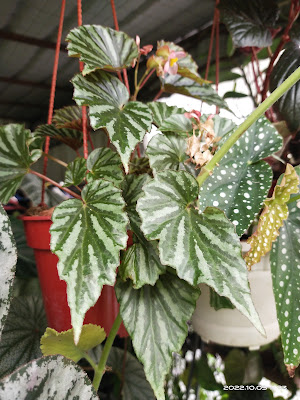INTRODUCTION:
This particular Cane Begonia is often behaves like Bamboo like Canes and often mis-identified as a Begonia 'Tamaya'. Commonly known as Angel Wing Begonia. The similarities are extremely close with many varieties especially with the polka dot begonia types - this one falls into the Maculata types. Currently it is identified as a Begonia coccinea in the plant market.
This particular Cane Begonia is often behaves like Bamboo like Canes and often mis-identified as a Begonia 'Tamaya'. Commonly known as Angel Wing Begonia. It's actually not a true name as 'Tamaya' is actually referred as a style where the bamboo like cane begonia been groomed as such like an umbrella feather where the plant is just a cane and rising up forming many shoots coming forth from top crown - like a topiary style.
This growing condition style is called "Standard Form" as such identified as 'Tamaya'.
And such - You can actually groom the 'Tamaya' style to any Cane Begonias that have that bamboo like features - especially the Albo picta species, Lucerna species and the ones that appears to be hardy.
CHARACTERISTICS:
Cane Begonia Maculata 'Albo Picta' has a symmetrical leaf pair formed on the stem very much creating the 'wings' formation on the bamboo like stem. The foliage however has strong speckles like white dots on its surface and may fade if receive too much light - however with that condition - chances of this particular begonia have high chance to bloom. Flowers are usually in pendulus with pink heart shaped buds - sometimes can turn to stronger red tones depending on the light received.
CARE & MAINTENANCE:
Just like most begonia plant needs - they requirements are very much the same,
MEDIUM:
Just like most Cane Begonia species - this one is grown on a medium:
50% coco chip mixed with sand & potting mix. I found this medium used for propagation by the nursery owner - I had slightly added the same medium type and re-pot it in a bigger pot.
So far - the plant doubled it's size.
FEEDING:
UPDATE 2021 - REVIEW
1) STOP USING WOOD VINEGAR - KILLS THE PLANT
2) STOP USING MIXED FERTILISERS IN ONE MIX.
3) STOP USING OSMOCOTE - BURNS PLANTS.
CURRENT USE:
4) 1ST WEEK - DILUTED A & B FERTILISER - 1 CAP / HALF BUCKET OF WATER
5) 2ND WEEK - DILUTED VITAMIN B1 (ROOT HORMONE)- 1 CAP / HALF BUCKET OF WATER
I had used Osmocote fertiliser before and had found them very unreliable and unstable as to determine how much to use - too much and the plant withers away - too less and the plant doesn't grow to it's optimum size. Ideally using 3-4 pieces of Osmocote as fertilizer - 2 week once would be good but in case if it's over used - the begonia plant dies.
Instead I had switched to A & B diluted Fertiliser, spraying on the foliage and plant on weekly basis and they show some growth and stability.
On alternative week - I spray root hormone known as (Vitamin B1) a solution for stronger root growth as these are prone for root rot. Again I use in half strength - a capful with half bucket of water.
OTHER WORKABLE FERTILISER:
I had checked and done some research with other successful begonia growers and had found that they find these works best in their garden condition. I must say that different garden have their specific garden conditions and finding the right feeding solution as what works best in their own garden.
There are other successful fertiliser regime:
6) CHICKEN MANURE
7) COFFEE BASED FERTILISER
8) ORGANIC LIQUID FERTILISER
WATERING:
Slightly spray water once a day in the morning and refrain watering rainy days.
I do water twice a day on a dry and hot days - it's depending on the weather.
DIFFERENT TYPES OF CANE BEGONIAS
Other matters are very much similar with the general information about Cane Begonias.
Do click below for more information on Cane Begonias.
Cane Begonia Care & Cultivation information.






















































